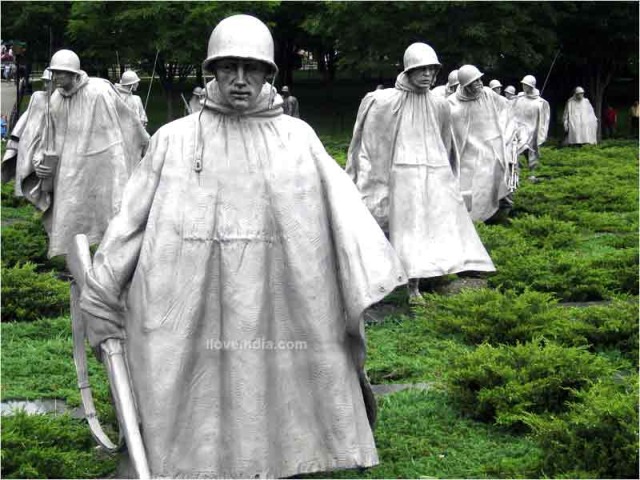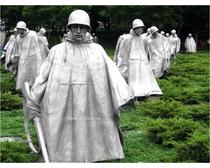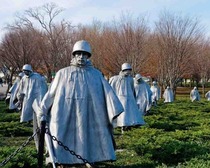Korean War Veterans Memorial brings to memory the lives of thousands of people who served in the Korean War. Check out some interesting facts about the Korean War Veterans Memorial.
Facts About Korean War Veterans Memorial
In the middle of the year 1950, a conflict between the Republic of Korea (South Korea) and the Democratic People's Republic of Korea (North Korea) brought the world to the brink of yet another international conflict, not long after the close of the Second World War. The conflict brought the international superpowers face to face with the possibility of an imminent nuclear war. People’s Republic of China and U.S.S.R supported the communist ruled North Korea, while the United Nations led by US supported South Korea. United States was perhaps the most active country in support of South Korea throughout the war, with more than 54,246 of its men dead, while another 103,284 U.S soldiers were left wounded. Add another 15,317 as either captured or missing during operations. For all those who had served bravely in America’s Unknown War, a beautiful memorial now stands in Washington D.C’s West Potomac Park. While there is the Reflecting Pool on the National Mall on the south, to the north east, it has the Lincoln Memorial in Ash Woods. Read ahead for some interesting facts about the Korean War Veterans Memorial.

Interesting & Fun Facts About Korean War Veterans Memorial
-
After the war, when one and a half million Americans returned home, they found U.S to be a country preoccupied with peace and prosperity, not with a war that took place nearly a half a world away. Thus, the war became known as "The Forgotten War”. To the Americans, the Korean War was the last thing they wanted to memorialize. So, the creation of this memorial itself was a great achievement.
-
It was only after the conclusion of the Vietnam Veterans Memorial that the idea to create such a memorial arose.
-
The Korean War Veterans Memorial was authorized by the U.S. Congress (Public Law 99-572) on October 28, 1986.
-
At first, the American Battle Monument Commission was authorized by Congress to create this memorial, but they failed to make much progress.
-
It was President Ronald Reagan, who created a Korean War Veterans Memorial Advisory Board, which chose the site for the memorial in September of 1988.
-
In the competition held for selecting the design of the memorial, the initial design selected was from a team of four architects of Pennsylvania State University. They later withdrew, as they were unable to accommodate the changes needed by the reviewing committees.
-
The eventual design selected was by the firm Cooper-Lecky Architects, which was in collaboration between several designers.
-
The groundbreaking for the Memorial happened on June 14, 1992 and the then President, George H. W. Bush conducted the event.
-
On July 27, 1995, the 42nd anniversary of the armistice that ended the war, President Bill Clinton and Kim Young Sam, President of the Republic of Korea, dedicated the memorial to the men and women who served during the conflict.
-
The memorial is in the form of a triangle intersecting a circle. The circle contains “the Pool of Remembrance”. The shallow pool has a 9m diameter. It is lined with black granite and surrounded by a grove of trees with benches.
-
The walls of the triangle are made of more than 100 tons of highly polished "Academy Black" granite from California. The walls are 50 m long and 20 cm thick.
-
Within the walled triangle are 19 stainless steel statues designed by Frank Gaylord, which depict soldiers on patrol facing an American flag. The statues are all larger than life and weigh nearly 1,000 pounds each.
-
Fourteen of the figures are from the U.S. Army, three are from the Marine Corps, one is a Navy Corpsman while the last one is an Air Force Forward Air Observer. The figures are in full combat gear, dispersed among strips of granite and juniper bushes, representing the rugged terrain of Korea.
-
On reflection from the walls, the soldiers appear to be 38 in number, representing the 38th parallel, which divides Korea.
-
On the main wall created by Louis Nelson, more than 2,500 photographic images have been sandblasted. These images were taken directly from photographs of soldiers, sailors, marines, and airmen who fought in the conflict.
-
Right next to the “Pool of Remembrance” there are inscriptions which list the number of American and United Nation’s soldiers killed, wounded, missing in action, and held as prisoners of war side by side.
-
In another nearby plaque are the words "Our nation honors her sons and daughters who answered the call to defend a country they never knew and a people they never met" inscribed.
-
On the south side of the memorial, there are three bushes of South Korea’s national flower, the Rose of Sharon.
-
"Freedom Is Not Free", this is an inscription inlaid in silver on a nearby Granite wall.


See also
More from iloveindia.com
- Home Remedies | Ayurveda | Vastu | Yoga | Feng Shui | Tattoos | Fitness | Garden | Nutrition | Parenting | Bikes | Cars | Baby Care | Indian Weddings | Festivals | Party ideas | Horoscope 2015 | Pets | Finance | Figures of Speech | Hotels in India : Delhi | Hyderabad | Chennai | Mumbai | Kolkata | Bangalore | Ahmedabad | Jaipur
- Contact Us Careers Disclaimer Privacy Policy Advertise With Us Lifestyle Sitemap Copyright iloveindia.com. All Rights Reserved.







